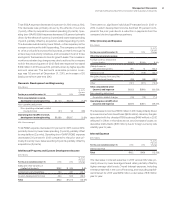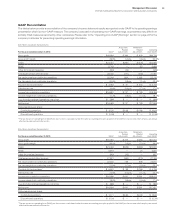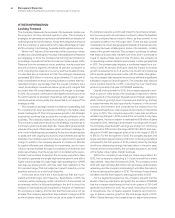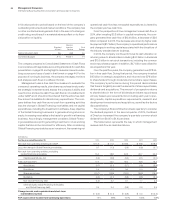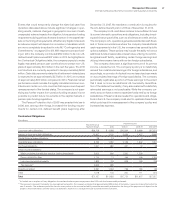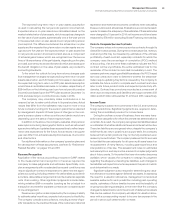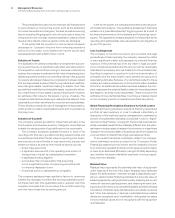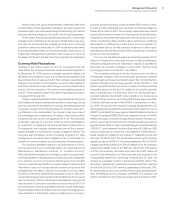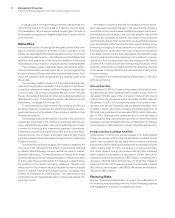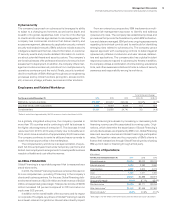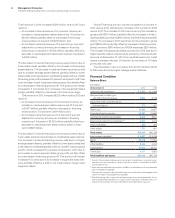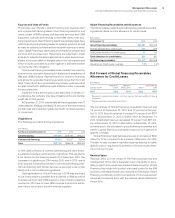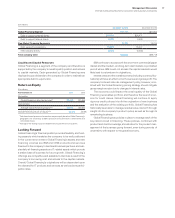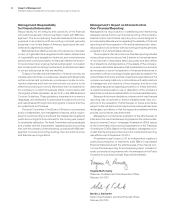IBM 2014 Annual Report Download - page 71
Download and view the complete annual report
Please find page 71 of the 2014 IBM annual report below. You can navigate through the pages in the report by either clicking on the pages listed below, or by using the keyword search tool below to find specific information within the annual report.70 Management Discussion
International Business Machines Corporation and Subsidiary Companies
The consolidated provision for income taxes will change period
to period based on nonrecurring events, such as the settlement
of income tax audits and changes in tax laws, as well as recurring
factors including the geographic mix of income before taxes, the
timing and amount of foreign dividend repatriation, state and local
taxes and the effects of various global income tax strategies.
To the extent that the provision for income taxes increases/
decreases by 1percent of income from continuing operations
before income taxes, consolidated net income would have
decreased/improved by $200 million in 2014.
Valuation of Assets
The application of business combination and impairment account-
ing requires the use of significant estimates and assumptions.
The acquisition method of accounting for business combinations
requires the company to estimate the fair value of assets acquired,
liabilities assumed, and any noncontrolling interest in the acquiree
to properly allocate purchase price consideration between assets
that are depreciated and amortized from goodwill and indefinite-
lived intangible assets. Impairment testing for assets, other than
goodwill and indefinite-lived intangible assets, requires the alloca-
tion of cash flows to those assets or group of assets and if required,
an estimate of fair value for the assets or group of assets. The
company’s estimates are based upon assumptions believed to be
reasonable, but which are inherently uncertain and unpredictable.
These valuations require the use of management’s assumptions,
which would not reflect unanticipated events and circumstances
that may occur.
Valuation of Goodwill
The company reviews goodwill for impairment annually, in the
fourth quarter, and whenever events or changes in circumstances
indicate the carrying value of goodwill may not be recoverable.
The company assesses qualitative factors in each of its
reporting units that carry goodwill including relevant events and
circumstances that affect the fair value of reporting units. Exam-
ples include, but are not limited to, macroeconomic, industry and
market conditions; as well as other individual factors such as:
• A loss of key personnel;
• A significant adverse shift in the operating environment of
the reporting unit such as unanticipated competition;
• A significant pending litigation;
• A more likely than not expectation that a reporting
unit or a significant portion of a reporting unit will be sold
or otherwise disposed of; and
• An adverse action or assessment by a regulator.
The company assesses these qualitative factors to determine
whether it is necessary to perform the two-step quantitative good-
will impairment test. This quantitative test is required only if the
company concludes that it is more likely than not that a reporting
unit’s fair value is less than its carrying amount.
In the fourth quarter, the company performed its annual good
-
will impairment analysis. The qualitative assessment illustrated
evidence of a potential impairment triggering event as a result of
the financial performance of the Systems and Technology report-
ing unit. The quantitative analysis resulted in no impairment as the
reporting unit’s estimated fair value exceeded the carrying amount
by over 100percent.
Loss Contingencies
The company is currently involved in various claims and legal
proceedings. At least quarterly, the company reviews the status
of each significant matter and assesses its potential financial
exposure. If the potential loss from any claim or legal proceed-
ing is considered probable and the amount can be reasonably
estimated, the company accrues a liability for the estimated loss.
Significant judgment is required in both the determination of
probability and the determination as to whether an exposure is
reasonably estimable. Because of uncertainties related to these
matters, accruals are based only on the best information available
at the time. As additional information becomes available, the com-
pany reassesses the potential liability related to its pending claims
and litigation, and may revise its estimates. These revisions in the
estimates of the potential liabilities could have a material impact
on the company’s results of operations and financial position.
Global Financing Receivables Allowance for Credit Losses
The Global Financing business reviews its financing receivables
port folio at least quarterly in order to assess collectibility. A
description of the methods used by management to estimate the
amount of uncollectible receivables is included in noteA, “Signifi-
cant Accounting Policies,” on page 95. Factors that could result in
actual receivable losses that are materially different from the estim-
ated reserve include sharp changes in the economy, or a significant
change in the economic health of a particular client that represents
a concentration in Global Financing’s receivables portfolio.
To the extent that actual collectibility differs from manage-
ment’s estimates currently provided for by 10percent, Global
Financing’s segment pre-tax income and the company’s income
from continuing operations before income taxes would be higher
or lower by an estimated $58 million (using 2014 data), depending
upon whether the actual collectibility was better or worse, respec
-
tively, than the estimates.
Residual Value
Residual value represents the estimated fair value of equipment
under lease as of the end of the lease. Residual value estimates
impact the determination of whether a lease is classified as oper-
ating or capital. Global Financing estimates the future fair value of
leased equipment by using historical models, analyzing the current
market for new and used equipment, and obtaining forward-look-
ing product information such as marketing plans and technological
innovations. Residual value estimates are periodically reviewed
and “other than temporary” declines in estimated future residual
values are recognized upon identification. Anticipated increases
in future residual values are not recognized until the equipment
is remarketed.



